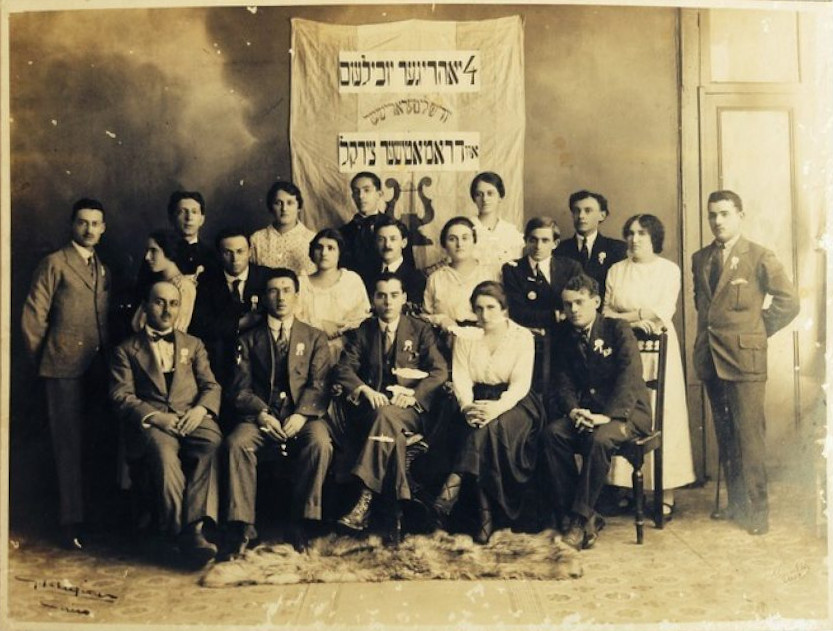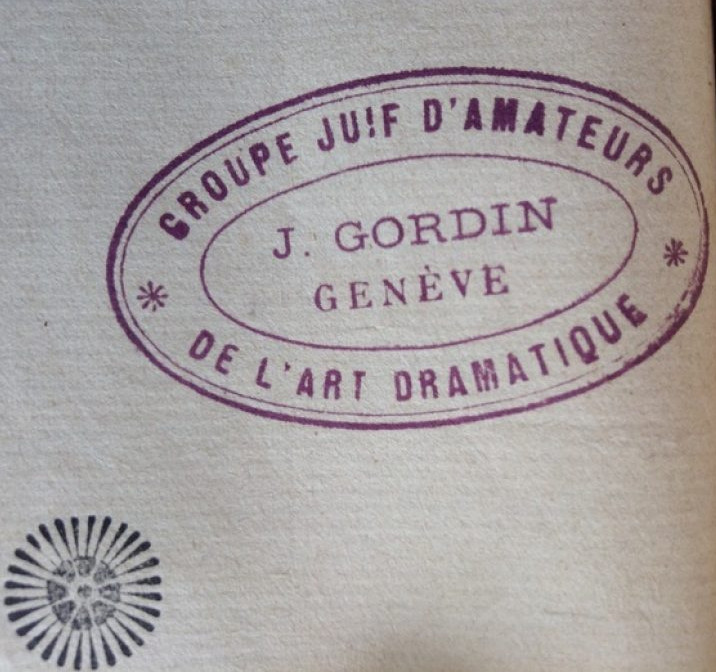An Amateur Yiddish Theater in Cairo

I BOUGHT THIS photograph on eBay, intrigued by the combination of the Cairo photographer’s mark and the Yiddish language banner.
Who are these smartly-dressed young men and women? And why are they all wearing white ribbons? We can sense a certain earnestness and a strong sense of pride in their carefully posed ranks. But with no names, dates or inscription on the back on the photo, what can we learn from it?
The improvised banner, with new lettering fixed to the original cloth, reads: “4 yoriger yubileum yudish literarisher un dramatisher tsirkl” – the 4th Anniversary of the Jewish Literary and Dramatic Circle.
So what’s a group like this doing in Cairo?
Cairo’s large and well-integrated Jewish community was mainly Arabic and French speaking in the late 19th and early 20th centuries. But, just as in Constantinople and Baghdad, from at least the mid 19th century onwards there was also a constant presence of Ashkenazi Jews – workers, artisans, traders and professionals. Their main languages would have been Yiddish, Russian and Polish. (And of course many people in both groups would also have had some proficiency in Hebrew).
Cairo’s secular Jewish cultural products – its songs, theatre, literature and journals – were thus a complex hybrid of overlapping languages and subcultures, connected both to the popular culture of the Arab street but also to high society and the elites. Within this melting-pot, Yiddish culture also gained a foothold by the early 20th century.
In the Yiddish language, yudish (an alternative spelling of yidish) can mean both Jewish and Yiddish, and our Circle is in fact a Yiddish amateur dramatic society. For more on its history, we can follow in the footsteps of one of the finest historians of modern Yiddish (and a pioneer of digital Yiddish scholarship), the late Leonard Prager. Omnivorously curious about global Yiddish culture, Prager wrote an article in 1992 titled “Yiddish Theatre in Cairo”, based on a small archive he found in the YIVO Institute in New York.
Prager tells us that Der yudisher literarisher un dramatisher tsirkl fun kayro (The Cairo Jewish Literary and Dramatic Circle, also known under its French name Le circle litteraire et dramatique du Caire ) was founded on 3 September 1912 by a group of amateur lovers of Yiddish culture.
His article includes a grainy image of the man sitting proudly in the front centre of our photograph, Joseph Weinstein, described as “an attorney with a deep attachment to Yiddish culture [who] founded the group and directed most of its performances…Odessa-born and formerly resident in Palestine, he was the key personality in the Ashkenazic community’s dramatic and radio activities.”
Prager also reveals that the Circle held a memorial meeting on 10 September 1916 to mark the recent passing of the revered classic Yiddish writers Y L Peretz (1852-1915) and Sholem Aleichem (1859 – 1916). We can therefore assume that our photograph was taken at this gathering, which would also explain the white memorial ribbons worn by all twelve men and seven women.
Cairo’s Yiddish theatre enthusiasts were part of a worldwide trend for Yiddish amateur dramatics. Similar groups sprang up from Shanghai and Baku to Montreal and Geneva, and right across the Yiddish-speaking heartlands of central and eastern Europe and the Americas. Inspired by the new art theatre repertoire of the Yiddish stage from Jacob Gordin onwards, they typically flourished from the 1900s to the 1930s.
Many stars of the professional Yiddish stage started out in workers’ theatre groups or amateur immigrant clubs. Some, like the New York Artef drama studio (the name stood for Arbeter teater farband – the Workers Theatrical Alliance) were as serious as any professional company and produced some of the most acclaimed avant-garde productions of the 1920s and 30s. Most such groups faded after a few years, but not all: Milwaukee’s Perhift group (another acronym, standing for Perets Hirshbeyn folks teater) lasted from the 1920s into the 1970s.

The Cairo Jewish Dramatic Circle lasted until at least 1948, when the war between Israel and its neighbours transformed the fortunes of the city’s Jewish community. According to Leonard Prager, the Circle maintained an extensive archive of its meetings and performances at its club rooms in the same building as the Ashkenazi Synagogue, but all these records were destroyed in a fire on 2 November 1945.
Few amateur Yiddish theatre groups left any surviving records. The occasional photograph in private hands is often all that remains. This photograph was put on ebay by an Israeli stamp dealer, so it seems likely that one of the members of the Circle, or their descendants, brought it with them when they emigrated.
And finally, as a further tribute to Cairo’s richly multicultural past, let us acknowledge the role of the photographer who took this image and whose signature and stamp is on the print. An Armenian called Gabriel Lekegian, his studio was one of the most fashionable in the city from the 1880s until the 1910s. The Armenian heritage project Lusadaran is currently researching his legacy and planning an exhibition of his work.

Article Author(s)
